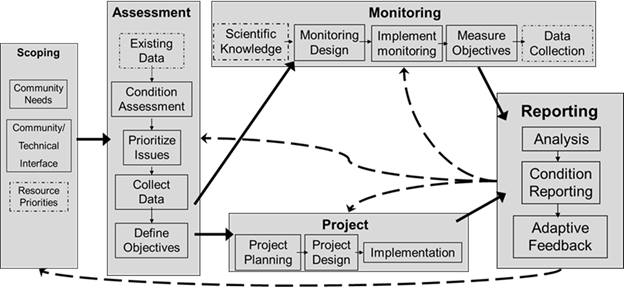Abundant and clean water quality conditions and productive fish populations are dependent on healthy floodplain and river channel ecosystems. The Umatilla River Vision, developed under guidance of the Umatilla Tribe’s First Foods Concept, defines a functional river as a dynamic environment that incorporates and expresses ecological processes that continue the natural production of First Foods used by the Tribal community.
The River Vision provides direction for restoration by identifying physical and ecological processes of a highly functional and dynamic river system and focusing on five key “touchstones”: hydrology, geomorphology, connectivity, riparian vegetation, and aquatic biota.
Operating under this guidance, CTUIR projects are planned, designed, implemented, and monitored across the usual and accustomed harvesting areas to achieve fish habitat restoration goals in support of sustainable aquatic First Foods integral for Tribal use.
The River Ecosystem Planning Approach
The Fisheries Habitat Program protects and enhances channel and floodplain function to maintain and restore aquatic habitat deficiencies through a systematic, holistic watershed planning approach termed the Riverine Ecosystem Planning Approach.

This approach includes the prioritization of focal areas and management practices focused on addressing fish lifecycle limiting factors.
This approach includes the prioritization of focal areas and management practices based on key species utilization of existing and historic available habitat,and limiting factors with a mechanism for riverine planning that utilizes scientifically defensible techniques.
The Approach Includes 5 Steps
Scoping
Scoping allows for public interface with the community and other stakeholders, and through a collaborative process identifies resource issues and concerns, needs, and restoration priorities
Assessment
The resource issues and concerns identified through scoping can guide development of an assessment of historic, current and desired conditions. Watershed, sub-subwatershed or reach based assessments support development of scientifically defensible aquatic based restoration plans that quantitatively prioritize geographic areas according to the potential for restoration and conservation of watershed/floodplain processes and define restoration objectives that support sustainable fish populations and their habitat.

Monitoring
Monitoring plans that utilize scientific knowledge and accepted methodology are then developed to measure achievement of project objectives.
Implementation
During the implementation stage, project restoration actions are designed to address fish limiting factors (ecological concerns) through means that restore natural channel and floodplain processes.
Reporting
The final stage of reporting provides an opportunity to summarize monitoring and project actions and evaluate project effectiveness. Adaptive management or feedback loop is critical to ongoing quality assurance and informing future restoration actions in order to meet program and project restoration objectives.
Adaptive Management
Measured physical and ecological results and learned experiences from project effectiveness monitoring, Columbia Basin and local action effectiveness monitoring, mainstem Columbia Basin and tributary fish life history monitoring, and other watershed monitoring reports and publications inform adaptive management across all stages of the Riverine Ecosystem Planning Approach.